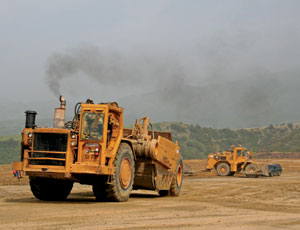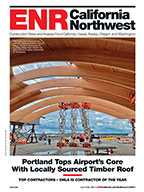The California Air Resources Board admitted recently that today’s off-road diesel equipment will easily meet the state’s emission goals for many years to come. However, the board is not giving up on pushing forward its regulatory agenda of monitoring and controlling the emissions of the industry’s construction fleets.

What may console the construction industry, however, is an expected series of delays to CARB’s nitrogen oxide (NOx) and particulate matter reductions, which were scheduled to kick in this year for large fleets (over 5,000 hp), in 2013 for medium fleets (2,501 to 5,000 hp) and in 2015 for small fleets (2,500 hp and under). Instead of indefinite delays, industry groups that have been battling CARB for years over what they call unsound, sloppy science say it’s time to repeal the current regulations and start over.
“I think CARB is struggling,” says William Davis, executive director of the Southern California Contractors Association. “It realizes it made some terrible estimates of emissions, but it just can’t give it up.” Industry groups maintain that regulated fleets will fall well below emission levels for at least the next 15 years.
Through a long series of workshops, now ongoing across the state, CARB yet again is collecting data on the current inventory of equipment—such as how many hours the equipment is used, load factor (how hard the engines are used) and diesel emissions—to get its arms around an accurate air-quality estimate.
“The mission changes all the time,” admits Erik White, assistant chief of CARB’s mobile force control division, speaking about the constantly changing data. White says that, prior to the 2007 rule-making for the off-road regulations, data on emissions without the inventory was in the “guesstimate” range. But, beginning in 2008, the recession and subsequent slowdown in construction activity affected everything that had been reported previously, as more machines were idled.
Once the new reporting requirement went into effect in April 2009, fleet owners registered equipment via the Diesel Off-Road Online Reporting System (DOORS). CARB says it was then able to start making some solid projections. “Our key data sources showed drastic reductions, by up to 50%,” says Todd Sax, CARB’s chief of the mobile source analysis group. The workshops will conclude in early October, followed by another round of regulatory processes with new rules possibly unveiled this December.
Despite the recount, CARB says a rule is still needed to combat poor air quality. “We recognize the construction industry’s world,” says Sax. “But there is a still a strong need for a rule in order to reduce health risks in the state. We’re all fortunate to have reduced emissions because of the recession … we can take the time to come up with less complex regulations.”
As the latest decision went public, CARB released a report on fine-particle pollution based on scientific assessments completed by the U.S. Environmental Protection Agency. The report reiterated that there is a “causal relationship” between exposure to fine PM and premature death. In the case of California, that is approximately 9,000 deaths annually.
The report, mandated every five years, was completed this spring and included a peer review by the federal Clean Air Scientific Advisory Committee. Released in June, a risk-assessment report, which focused on a study regarding estimates of premature deaths associated with exposure to fine-particle pollution and involving about 500,000 people in 116 U.S. cities, included data from Los Angeles and Fresno. CARB used the same methodology, along with data from 90 fine-particulate monitoring stations in the state, to make its estimate.
However, says Mike Kennedy, general counsel for the Associated General Contractors of America, the particulate matter is not coming from construction equipment. National AGC is involved because the rules potentially could spread to other states. Still, even in California, the rules are not enforceable until EPA gives CARB permission. Then, it could take a year to get organized for enforcement, which would cause contractors to suffer considerable “distress,” Kennedy says.
The industry is not resting on this first victory. “The implementation of this regulation is coming at a time when the contractors can ill afford to fork out millions of dollars to retrofit a fleet of vehicles that has an expected life span of over 30 years,” says Thomas Holsman, CEO of the Associated General Contractors of California. “Considering that CARB’s goals already have been met, enforcing the regulation … will only exacerbate the ability to create jobs—and that’s what this state needs right now.”
In April, AGC presented a study prepared by Sierra Research using CARB’s revised data showing that California’s fleet emissions are less than 28% of what state officials had estimated. Further, earlier this year, it was discovered the lead scientist in a CARB study on particulate matter falsified his academic credentials.



Post a comment to this article
Report Abusive Comment